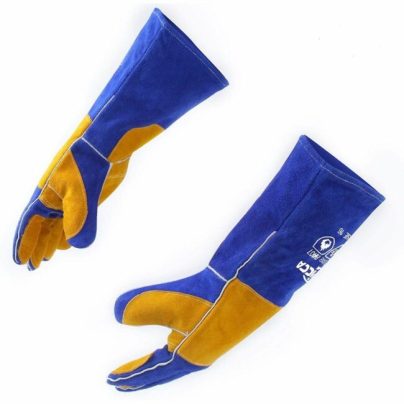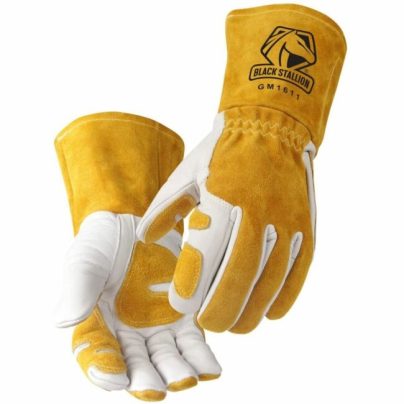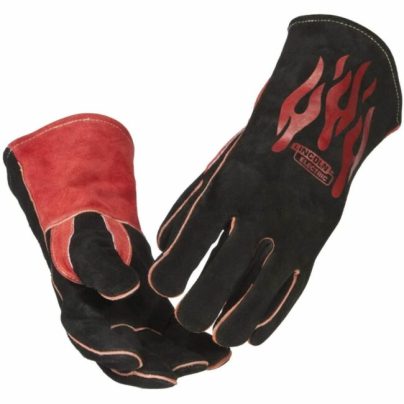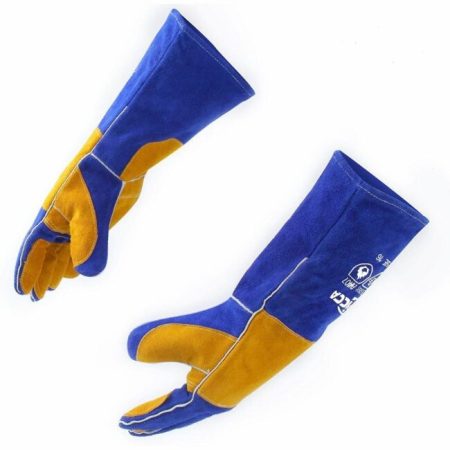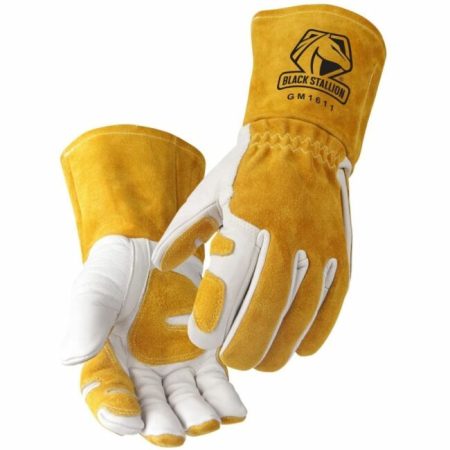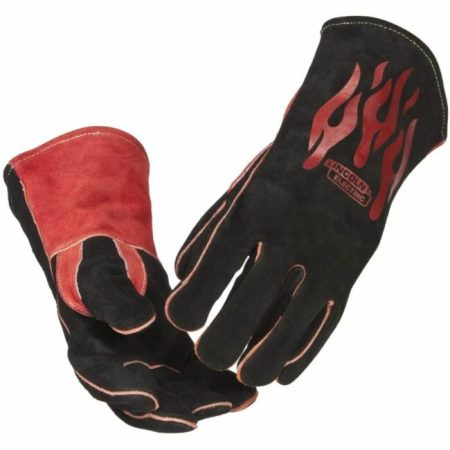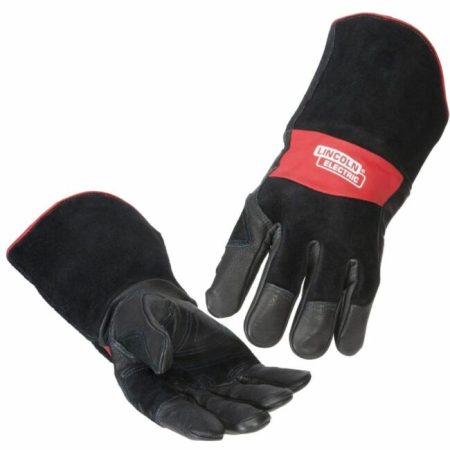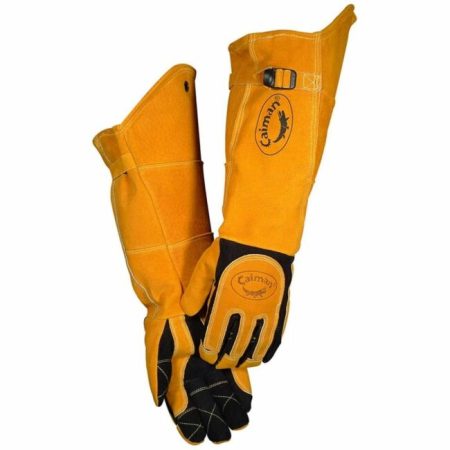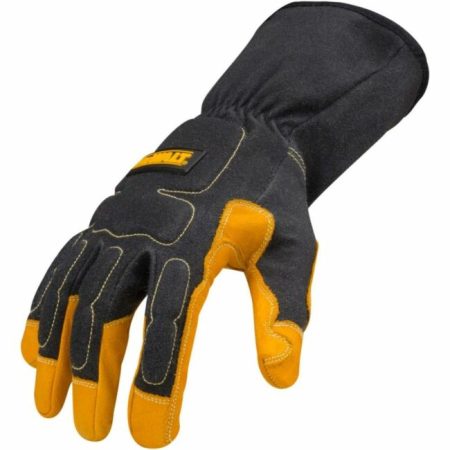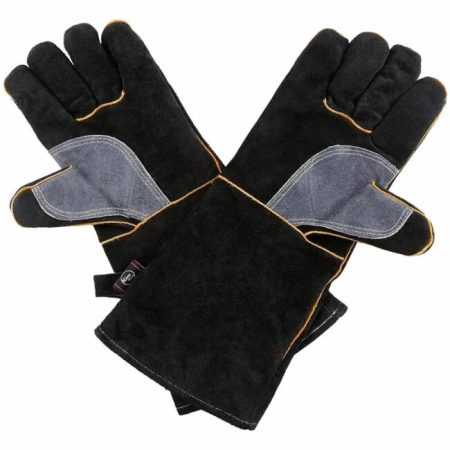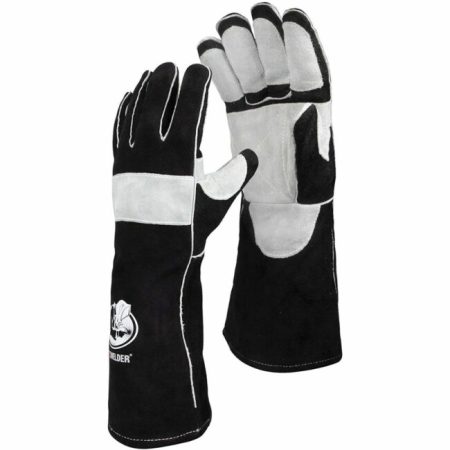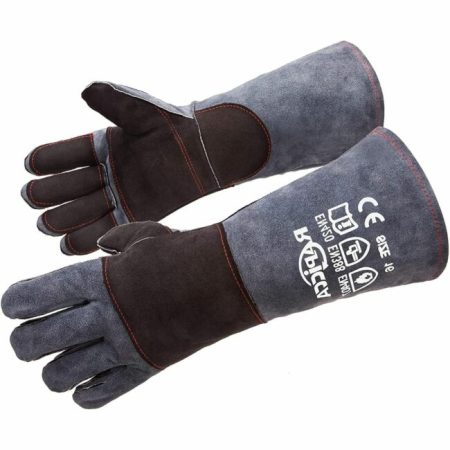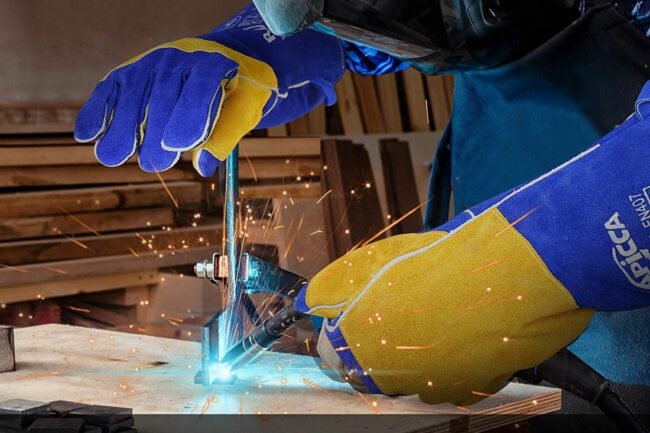
We may earn revenue from the products available on this page and participate in affiliate programs. Learn More ›
Welding can produce temperatures upward of 10,000 degrees Fahrenheit, making it absolutely essential to have the right gloves for the job. A good set of welding gloves will ensure one’s hands, wrists, and forearms are properly protected during TIG, MIG, or stick welding. Even those who don’t weld can make use of a good set of welding gloves for more common household activities involving high heat, such as grilling or tending to a backyard fire pit.
Welding gloves consist of thick leather layered with heat-resistant material such as aluminum foil and stitched together with Kevlar threading. These specialty gloves are capable of enduring extended exposure to surfaces up to 932 degrees Fahrenheit and radiant heat that exceeds 2,000 degrees Fahrenheit. In addition to being heat resistant, these gloves also protect welders from cuts and abrasions, plus guard against electric shock. This guide will explore what characteristics one should look for in a good set of welding gloves while reviewing some of the best welding gloves on the market.
- BEST OVERALL: Rapicca Blue Forge Welding Gloves
- RUNNER-UP: Black Stallion GM1611 Cowhide MIG Gloves
- BEST BANG FOR THE BUCK: Lincoln Electric Traditional MIG Stick Welding Gloves
- UPGRADE PICK: Lincoln Electric Leather MIG Stick Welding Gloves
- BEST COVERAGE: Caiman 21-Inch Deerskin Insulated Welding Gloves
- BEST FOR TIG WELDING: DeWalt Premium MIG/TIG Welding Gloves
- BEST FOR STICK WELDING: Kim Yuan Extreme Heat- & Fire-Resistant Gloves
- BEST HEAT-RESISTANT: YesWelder Heat-Resistant Welding Gloves
- BEST FOR MIG WELDING: Rapicca Leather Stick Welding Gloves
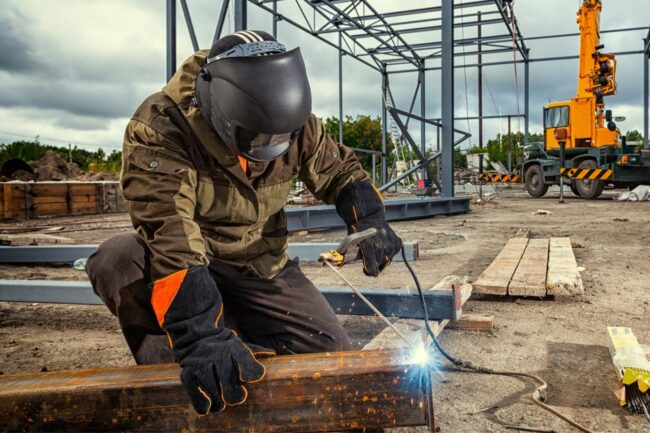
How We Chose the Best Welding Gloves
To bolster our research, we interviewed Farhan Siraj, the CEO of OSHA Outreach Courses, a nationwide company offering occupational safety training to a variety of industries. His advice on welding jackets came in handy when choosing our top picks. “Welding gloves are the most important component of PPE,” he says. “In a way, they are the first line of defense against injuries that seriously damage a worker.” He adds that shoppers will want to look for “heat-resistance leather or other advanced fabrics like Nomex, Kevlar and carbon fiber, which provide protection against high temperatures, flames, and sparks.”
With this expert advice in mind, we used a variety of criteria to review more than two dozen pairs of welding gloves for this guide. Since protection is crucial when it comes to welding gloves, we chose models that use materials that provide excellent heat protection with heat ratings of up to 932 degrees Fahrenheit. The gloves on our list consist of thick leather with insulation, such as aluminum foil, and heat-resistant Kevlar stitching. For the best MIG welding gloves and best stick welding gloves, we prioritized heat protection over flexibility. For the best TIG welding gloves, we looked for models that offer a better feel and range of motion while still providing adequate heat protection. Durability was also a factor, so we chose models that reinforced common wear points on gloves, including the palms and the area between the forefinger and thumb.
Our Top Picks
The list below includes some of the top welding gloves for TIG, MIG, and stick welding. All the gloves below can resist high heat and are constructed with long-lasting materials.
Best Overall
Rapicca Blue Forge Welding Gloves
Product Specs
- Material: Split cowhide leather, cotton, aluminum foil, and Kevlar
- Length: 16 inches
- Sizes: One size fits all
Pros
- Uses double-layered Kevlar padding; provides a high heat resistance of 932 degrees Fahrenheit
- Made with flame-retardant cloth and a comfortable soft cotton lining
- Puncture- and oil-resistant construction prevents injury and provides long-term durability
Cons
- Thicker construction makes them stiffer than other welding gloves
This set of welding gloves from Rapicca combines superior heat resistance with durable construction. They feature three layers of protection with an outer layer that consists of leather Kevlar padding, a middle layer of high-temperature resistant aluminum foil and flame-retardant cloth, and an inner layer of soft cotton. This heavy-duty construction gives the gloves the ability to withstand temperatures of up to 932 degrees Fahrenheit.
This is also one of the few pairs of gloves that use Kevlar padding on key contact points, including the palms, fingers, elbows, and backs. And with their 5.5-inch-long sleeve, the gloves offer comprehensive protection. In addition to resisting heat, the 1.5-millimeter leather is also puncture- and oil-resistant.
Get the Rapicca Forge welding gloves at Amazon or Rapicca.
Runner-Up
Black Stallion GM1611 Cowhide MIG Gloves
Product Specs
- Material: Grain and split cowhide leather and a cotton liner
- Length: 5 inches
- Sizes: S, M, L, XL, XXL
Pros
- Comfortable cotton liner and lightweight cowhide leather provide a good range of movement
- Includes drag patch and rest patch for durability and long-term use
- Multiple size options for a good fit
Cons
- Shorter cuff than other glove types; may not be ideal for some users
With a design that provides plenty of heat protection while allowing for adequate freedom of movement, the Black Stallion leather cowhide welding gloves are a worthy choice for MIG welding and some TIG welding applications. The gloves consist of cowhide leather, which is suitable for heat resistance while also soft enough to allow the wearer to comfortably move their fingers.
The gloves also include some thoughtful design features, including a drag patch on the outer hand and a rest patch on the wrist, allowing the wearer to safely rest their hands while working. There are also reinforced areas on the inner palm thumb and forefinger for added protection. A cotton liner makes the gloves comfortable to wear for long welding sessions. Revco’s welding gloves come in five size options for a more customized fit than most MIG welding gloves.
Get the Black Stallion welding gloves at Amazon.
Best Bang for the Buck
Lincoln Electric Traditional MIG Stick Welding Gloves
Product Specs
- Material: Split cowhide leather and Kevlar
- Length: 14 inches
- Sizes: 1 size fits all
Pros
- Affordably priced compared to other options on this list
- Kevlar stitching with a double layer of leather for premium quality and durability
- Reinforced thumbs prevent injury for added peace of mind
Cons
- Shorter cuff than other gloves; may not provide as much protection as some comparable options
- The one-size-fits-all design may not suit some users
While this set of gloves from Lincoln may be more affordable than other welding gloves on the market, they still provide plenty of protection for welding. A full leather outer reinforced with a split leather cowhide inner provides excellent heat protection. A reinforced leather patch around the thumb adds a layer of protection for the hands while extending the lifespan of the gloves. Kevlar stitching ensures the seams hold up against intense heat while a soft cotton inner adds comfort for those longer welding jobs.
For those who wish to weld in style, this pair features a flame design on the cuffs. While this pair of gloves offers great value, the one-size-fits-all design may not work for those with smaller hands.
Get the Lincoln Electric traditional welding gloves at Amazon or WeldingSupply.com.
Upgrade Pick
Lincoln Electric Leather MIG Stick Welding Gloves
Product Specs
- Material: Grain and split cowhide leather, twill cotton, flame-retardant foam, and Nomex
- Length: 12 inches
- Sizes: M, L, XL
Pros
- Made with durable grain and split cowhide leather; provides ample protection and dexterity
- Comes with flame-retardant foam, twill-cotton lining, and double-stitched Nomex for long-term use
- The 5-inch cuff protects against sparks, molten materials, and heat
Cons
- Comes in fewer sizes compared to other options on this list
Professional users can benefit from the heavy-duty, reliable features integrated into these Lincoln Electric leather welding gloves. These heavy-duty gloves are made with grain and split cowhide leather, which provide ample protection against heat and molten materials while being lightweight enough to provide the user with dexterity and ease of movement.
For added protection and durability, these gloves also come with a 5-inch cuff, flame-retardant foam, and twill cotton lining, as well as Nomex double stitching. Shoppers will want to note that the twill cotton absorbs sweat in high temperatures for added convenience, especially during long-term wear.
While the palms and backs of the gloves are made with softer materials, the fingertips of these gloves are made with durable leather to prevent injury. Finally, these gloves come in three sizes to fit multiple users.
Get the Lincoln Electric leather welding gloves at Amazon.
Best Coverage
Caiman 21-Inch Deerskin Insulated Welding Gloves
Product Specs
- Material: Deerskin leather, Kevlar, and boar hide
- Length: 21 inches
- Sizes: 1 size fits all
Pros
- Total forearm protection keeps the user’s hands, wrists, and arms safe
- Ergonomic shape for a better fit; curved cuffs contour to the user’s arm while the straps hold the gloves in place
- Kevlar stitching and leather construction for heat protection
Cons
- Expensive compared to similar products on the market
- A one-size-fits-all design may not suit all users
While most welding gloves focus on protecting the hands, wrists, and lower arms, this pair of welding gloves from Caiman runs to the elbows. This extended cuff length makes them ideal for applications in which the forearms are exposed, such as with overhead welding and pipe welding.
Curved cuffs that match the contours of the arm and a strap that secures to the upper arm create a secure fit. A boarhide leather shield patch on the palms and inner parts of the fingers provides additional heat protection. That added layer coupled with thick deerskin construction, Kevlar stitching, and reinforced patches at key touch points around the hands gives this set of gloves a reassuringly sturdy feel.
Get the Caiman welding gloves at Amazon or Grainger.
Best For Tig Welding
DeWalt Premium MIG/TIG Welding Gloves
Product Specs
- Material: Buffalo leather, Kevlar, and fire-resistant cotton
- Length: 13 inches
- Sizes: M, L, XL, XXL, XXXL
Pros
- Seamless design for excellent freedom of movement
- Reinforced thumb for better wear resistance and long-term use
- Buffalo leather allows for ample dexterity while in use
Cons
- Expensive compared to other options currently on the market
- The short cuff provides limited wrist and arm protection
With a design that allows for maximum freedom of movement while still providing plenty of heat protection, this set of welding gloves is ideal for TIG welding jobs that require more dexterity. DeWalt selected a double layer of buffalo leather, which has better abrasion resistance and heat resistance than the standard goatskin other TIG gloves use. DeWalt also applies an extra layer of insulation in vulnerable areas, such as the sides of the hands and the crook between the thumb and forefinger, for added protection.
Despite all this insulation, they remain surprisingly flexible, thanks to a seamless design that allows for better freedom of movement and five size options that allow the user to achieve a good fit regardless of their hand size.
Get the DeWalt welding gloves at Amazon, Lowe’s, or Acme Tools.
Best For Stick Welding
Kim Yuan Extreme Heat- u0026 Fire-Resistant Gloves
Product Specs
- Material: Cowhide leather, cotton, and denim
- Length: 14 inches
- Sizes: 1 size fits all
Pros
- Thick leather design can handle higher temperatures than some of its counterparts
- Cowhide leather resists scuffs and punctures for long-term reliability
- Cotton interior adds comfort while in use
Cons
- Size may be too large for those with smaller hands
With their 1.2-millimeter-thick cowhide construction, this set of gloves is thick enough to handle the high heat of stick welding jobs while maintaining a good feel and dexterity. The gloves have a heat rating of 662 degrees Fahrenheit, are sufficient for stick welding, and feature long denim cuffs that protect against sparks and intense radiant heat.
The glove inners consist of soft cotton, which provides excellent comfort while absorbing sweat. Kevlar stitching and patches that reinforce the palm and area between the thumb and forefinger add durability, making the gloves less susceptible to abrasions and scuffs. While the Kim Yuan heat-resistant gloves feature a more fitted design, they may not suit all users since they come in only one size..
Get the Kim Yuan welding gloves at Amazon.
Best Heat-Resistant
YesWelder Heat-Resistant Welding Gloves
Product Specs
- Material: Cowhide leather, cotton, and Kevlar
- Length: 16 inches
- Sizes: 1 size fits all
Pros
- High-temperature rating of 932 degrees Fahrenheit
- The 16-inch length provides great coverage
- Double-layer palms and fingers add durability and peace of mind
Cons
- Stiffness limits the range of motion
- Gloves may be too large for some users
With their ability to withstand heat up to 932 degrees Fahrenheit coupled with a design that ensures they’ll hold up for a long time, this set of gloves from YesWelder is one of the best heat-resistant options on the market. The gloves consist of a thick leather outer with reinforced palms, fingers, wrists, and thumbs with a soft cotton liner.
Though their construction makes them stiffer than other welding gloves, the cowhide leather and reinforced seams prevent wear, ensuring these gloves will hold up for many jobs. With their 7.5-inch-long cuff, the gloves provide comprehensive protection, making them ideal for stick welding or non-welding applications, such as barbecuing or tending to a campfire.
Get the YesWelder welding gloves at Amazon.
Best For Mig Welding
Rapicca Leather Stick Welding Gloves
Product Specs
- Material: Split cowhide leather, cotton, aluminum foil, and Kevlar
- Length: 16 inches
- Sizes: M, L, XL, XXL, XXXL
Pros
- Length provides ample coverage for welding
- Durable construction with reinforced stitching and 1.5-millimeter-thick leather
- Superior heat resistance; can withstand over 932 degrees Fahrenheit
Cons
- The 1-size-fits-all design may not fit all users
With their ability to resist extreme heat while providing ample coverage, this set of welding gloves from Rapicca is well suited for the rigors of MIG welding or even a long day of backyard barbecuing. They’re equipped with Kevlar-insulated padding on the fingers with an aluminum foil layer that reflects heat, making them suitable for withstanding scorching temperatures of up to 932 degrees Fahrenheit.
At 16 inches long with a 7.5-inch-long cuff, these gloves provide the protection needed for MIG welding jobs, and the cotton lining offers comfort during long periods. In addition to being heat-resistant, the thick split cowhide leather with reinforced stitching also resists wear and abrasions.
Get the Rapicca stick welding gloves at Amazon.
Jump to Our Top Picks
What to Consider When Choosing Welding Gloves
Understanding how gloves are designed to meet the needs of different welding processes is crucial to choosing the right set of gloves. Ahead, learn about the different types of welding gloves and the features one should consider when shopping for a pair of their own.
Welding Processes
There are three main types of welding—TIG, MIG, and stick welding. TIG welding produces less heat and requires the operator to have more touch and feel, hence the best TIG gloves are thinner. MIG welding radiates more heat and produces sparks. As such, the best MIG gloves have more layers of material to offer maximum heat protection and longer cuffs for better coverage. Stick welders produce high heat and require dexterity, so gloves designed for this purpose must strike a balance between heat resistance and flexibility.
Welding Glove Materials
Welding gloves use a variety of animal skins in the construction of the outer layer. Cowhide is the thickest and therefore provides the most protection, making it a common choice for MIG welding; however, it’s often too stiff for TIG welding. Goatskin doesn’t provide the same level of heat protection but is more flexible, making it the material of choice for TIG welding. Welding glove inners typically consist of soft cotton, which is comfortable on the hands and will absorb sweat.
Heat Resistance
Heat resistance is key when it comes to welding gloves. The materials described above largely determine just how heat resistant a glove is. Thicker animal hide will resist heat better than thinner materials. Additional layers of material such as aluminum reflect heat, adding to the gloves’ heat resistance. A glove’s heat resistance is dependent upon how long the glove is in contact with heat. Most welding gloves can withstand contact with metals heated up to 2,000 degrees Fahrenheit for short periods and temperatures of up to 932 degrees Fahrenheit for longer periods.
Stitching and Insulation
Welding gloves typically use Kevlar stitching, which, unlike nylon or polyester, is fire retardant and won’t melt or stretch. Gloves capable of resisting extreme heat will often also use a layer of heat-reflecting material such as aluminum foil and flame retardant cloth. These additional layers of insulation raise the heat resistance rating of the gloves.
Size
Welding gloves vary in size depending on the welding type. Since MIG welding gloves do not require the dexterity of TIG welding gloves, they typically come as one size fits all. Since TIG and stick welding gloves require more feel and range of motion, they typically come in size options that range from small to extra large. In addition to size, some gloves are longer than others. TIG welding gloves typically do not require as much protection as MIG welding gloves and hence have shorter cuffs that are around 5 inches. MIG and stick welding require more protection and have cuffs that extend 7.5 inches or longer. Welding gloves designed for pipe or overhead welding have cuffs that extend all the way to the elbows.
FAQs
If you’re wondering how TIG welding differs from MIG welding or what other dangers a welding glove will protect you from, then read on for more information about this specialty handwear.
Q. What is the difference between MIG and TIG welding gloves?
MIG welding gloves are thicker and provide more heat protection and coverage to suit MIG welding applications. TIG gloves, in comparison, are thinner to allow for the feel and dexterity required by TIG welding jobs.
Q. What gloves should I get for stick welding?
Stick welding gloves require a combination of ample heat resistance and thin enough materials to allow for dexterity. See the Top Picks List above for links to specific products.
Q. Why do most welding gloves have a cuff?
Most welding gloves have a cuff to provide protection for forearms, which can be exposed to high radiant heat or sparks produced by the welding process. Cuffs also work well with additional welding safety gear, such as fire-resistant sleeves, welding boots, and welder jackets.
Q. Are Kevlar gloves good for welding?
Kevlar liner is sometimes used for welding gloves due to its heat-resistant properties. However, Kevlar is also used for stitching in welding gloves, as it won’t burn or melt at high temperatures like nylon or polyester.
Q. What type of apron is used during arc welding?
Arc welding aprons are typically made from durable and fire-resistant materials such as pigskin or cowhide leather, both of which protect welders from sparks and radiant heat.
Q. How long should a pair of welding gloves last?
How long a pair of welding gloves lasts depends on the frequency of use as well as quality. That said, a good pair of welding gloves that sees regular use will typically last for up to 12 months.
Q. How can I prevent cuts and punctures on welding gloves?
A good set of welding gloves will protect against cuts and punctures by reinforcing vulnerable parts of the gloves, such as the palms and inner parts of the fingers, with additional layers of leather.
Why Trust Bob Vila
Bob Vila has been America’s Handyman since 1979. As the host of beloved and groundbreaking TV series including “This Old House” and “Bob Vila’s Home Again,” he popularized and became synonymous with “do-it-yourself” home improvement.
Over the course of his decades-long career, Bob Vila has helped millions of people build, renovate, repair, and live better each day—a tradition that continues today with expert yet accessible home advice. The Bob Vila team distills need-to-know information into project tutorials, maintenance guides, tool 101s, and more. These home and garden experts then thoroughly research, vet, and recommend products that support homeowners, renters, DIYers, and professionals in their to-do lists.
